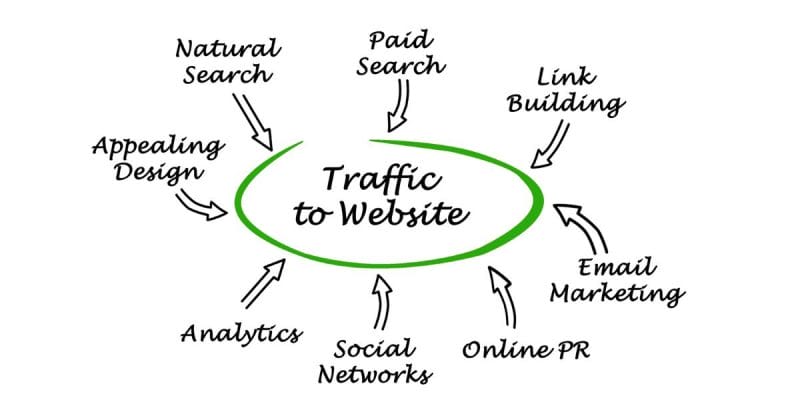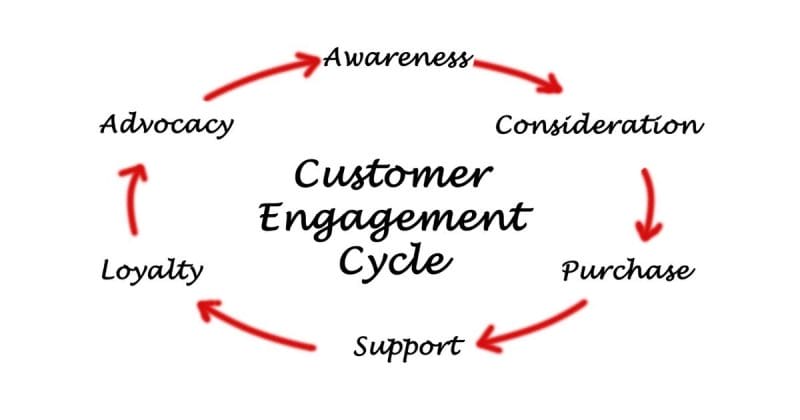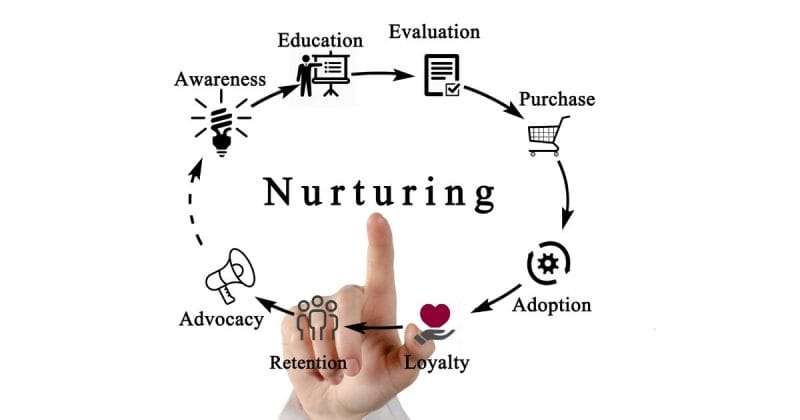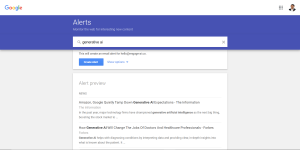Every potential customer represents a valuable opportunity for a business. As businesses strive to establish meaningful connections with their audience, the journey from initial interest to conversion becomes a crucial pathway.
In this blog article, we delve into the strategies and tactics that empower businesses not just to attract leads but to nurture them strategically. Whether you’re a seasoned marketer seeking fresh insights or a business owner aiming to refine your lead nurturing game, this article is your compass to navigate the intricate terrain of lead nurturing.
Maximizing Website Lead Generation: Turning Visitors into Leads

Before we delve into lead nurturing, let’s take a look at how you can effectively generate more leads for your business.
Website lead generation is an integral element of digital marketing strategies, helping businesses capture customer interest and convert it to actionable data.
According to one survey, 63% of marketers consider website lead generation their top marketing challenge. Businesses can leverage digital marketing strategies effectively to overcome website lead generation hurdles and successfully convert website visitors into actionable leads.
To maximize its potential, this requires an approach comprised of high-quality content production, search engine optimization techniques, and conversion pathways such as contact forms, quote requests, or targeted offers.
- Utilizing High-Quality Content: Engaging, relevant content is key in drawing customers to your website and increasing conversion rates. Engaging content not only increases its visibility but also enhances user experience, leading to higher conversion rates.
- Search Engine Optimization (SEO): Implementing SEO techniques helps a website rank higher on search engine results pages (SERPs). A higher SERP position increases the chances of customers finding and visiting your website, thus creating more opportunities for lead generation.
- Utilizing Conversion Pathways: These are specific actions you wish for site visitors to perform that will convert them into actionable leads, such as filling out contact forms, requesting quotes, or accepting targeted offers.
Understanding Visitors' Psychology: Crafting Messages that Resonate
What makes your website visitors tick?
Before we can start capturing and engaging leads, it’s vital to understand the user behavior of your website visitors. Statista found that 94% of organizations that adapt their website content in accordance with user psychology experience significant increases in lead conversion rates.
With this understanding comes an ability for businesses to craft messages that resonate with user desires, thereby compelling targeted actions on both websites and emails. This, in turn, boosts engagement rates by 68%.
Instant Gratification
It’s not just kids who want swift rewards.
Consider online purchasing behavior. Based on the 2023 research published in the Journal of Consumer Behaviour, more than 70% of internet users display impulsive buying behavior due to convenience and instant service.
In other words, potential customers want options that offer instantaneous results.
Understanding such aspects of user psychology allows marketers to craft compelling calls to action, leading to higher click-through rates and lead generation.
Aligning Content with User Psychology
Adapting website content to match user behavior can significantly boost lead conversion rates.
1. Audience Segmentation
- Identify and segment your audience based on demographics, behavior, and preferences.
- Use tools like Google Analytics 4, customer surveys, and user behavior tracking to understand your audience better.
2. Website Behavioral Analysis
- Analyze user behavior on your website to identify patterns and trends.
- Look at pages visited, time spent on each page, and interactions such as clicks and downloads.
3. Personalized Content
- Create personalized content based on your visitor’s web search preferences and intent.
- Tailor landing pages, product recommendations, and call-to-action (CTA) buttons to align with their interests.
- Use language and design elements that align with the user’s journey and intent.
4. Storytelling Techniques
- Utilize narratives that make your messages more relatable and memorable, enhancing their impact, such as Hero’s Journey.
- Use relatable characters, anecdotes, and real-world examples to make your message more memorable.
- Utilize visuals such as images, videos, and infographics to enhance your storytelling.
- Simplify complex concepts by using metaphors and analogies.
5. Responsive Web Design
- Ensure your website is responsive and provides a seamless experience across devices.
- Optimize content for mobile users, considering their unique behaviors and preferences.
6. Social Proof and Testimonials
- Incorporate social proof and customer testimonials to build trust and credibility.
- Highlight success stories or positive experiences that align with the user’s interests.
7. User Surveys and Feedback
- Gather feedback through surveys to understand user preferences and pain points.
- Use this information to make informed adjustments to your website content and messaging.
8. Website A/B Testing
- Conduct A/B testing to refine and optimize your messages.
- Test variations of headlines, images, and content to determine which versions perform best for different user segments.
9. Continuous Analysis and Adjustment
- Regularly review analytics data and user feedback.
- Stay agile and make adjustments to your messaging strategy based on evolving user behavior and market trends.
SEO Leads: Capturing High-Intent Traffic for Conversion
We’ve delved into the nuances of human psychology. Now let’s turn our attention to capturing high-intent traffic by winning over the search engine algorithms through effective SEO strategies.
High-intent traffic or visitors are marked by their readiness to engage or buy through their online behavior and interactions. Naturally, Search Engine Optimization (SEO) contributes greatly to driving this type of high-value traffic to websites. In fact, Backlinko’s study found that over 59% of those using search engines to solve their issues would click one of the first three search results, indicating strong intent. Moreover, many professionals consider lead generation as the second most expected outcome of SEO.
SEO-guided content can help generate leads, pushing high-intent visitors further down the conversion funnel and becoming part of an active, engaged audience that opens doors for more targeted and effective marketing strategies.
Strategies to Capture and Convert High-Intent Traffic
Here are some effective tactics for high-intent lead conversion:
- Encouraging Website Subscriptions: Optimize your website to attract high-intent traffic and encourage subscriptions.
- Leveraging Newsletter Subscriptions: Use newsletters as a direct communication channel. The reported industry-reported open rates range between 21-33%.
- Use White Papers: Providing your audience with a unique value report will highly improve your lead conversion chances. When visitors are looking for very specific information that is not widely available, they show little to no hesitation towards exchanging their email for that information.
- Monthly & Quarterly Reports: This is a very good way to distinguish yourself from other competitors. This is something that few websites will offer, but it can be achieved with little to no effort.
Two of the tactics above, encouraging website subscriptions and leveraging newsletter subscriptions, prove particularly successful at turning high-intent traffic into leads.
Website subscribers demonstrate an interest in your brand by subscribing to updates about it. A newsletter subscription is another good way of tapping into their interest and turning them into leads.
Growing Website Subscribers: A Gateway to Long-Term Engagement
Understanding the perceivable value that website visitors place on a visit is of vital importance, as this has an immense effect on subscriber growth rates. An insightful study conducted by the Journal of Interactive Marketing highlights this aspect. Researchers discovered that when users perceive high value in a website’s content, their propensity to become leads by subscribing increases significantly.
Satisfying visitors’ perceptual value becomes ever more critical in an environment in which, as per Statista’s 2023 report, global website bounce rates stand at 58.18%. Therefore, creating content that resonates with their psychology can open doors to long-term engagement and, therefore, create value.
Understanding and taking advantage of visitors’ psychology to increase website subscribership cannot be underestimated. A report published by Consumer Psychology Review highlights this factor, showing how visitors respond more favorably when presented with personalized content and a user-friendly interface, leading to an uptick in subscription rates.
There’s also evidence suggesting that reminders about unsubscribed content can tap into the fear of missing out, which in turn induces conversions. This suggests tapping into psychological triggers can secure high conversion rates and foster long-term engagement.
Strategies to Boost Website Subscriber Growth
- Enhance Perceived Value: Create content that resonates with visitors’ interests and needs.
- Use Psychological Triggers: Implement tactics like reminders about unsubscribed content to induce conversions.
- Optimize User Experience: Design your website for easy navigation and quick access to subscription options, ensuring a seamless user journey.
- Offer Incentives for Subscribing: Provide immediate value for new subscribers, such as exclusive content, discounts, or free resources.
Newsletter Subscribers: Crafting Content that Converts
Generating an effective newsletter requires content that not only appeals to target readers but also compels them to commit to the next action. A 2023 HubSpot study demonstrated the power of offering engaging, useful newsletters with regular, informative updates: they had 33% higher chances of turning leads into customers than those that didn’t send regular, informative newsletters. Thus, for maximum effectual results, focus on creating relevant, valuable, and trustworthy pieces of writing that add real benefit for subscribers and businesses alike.
Translating data-driven insights with an understanding of subscriber needs into action requires combining both data-driven insights and an empathic appreciation of subscriber needs.
Personalization strategies often enhance conversion; according to one Statista report, personalized newsletter content was associated with 14% higher click-through rates and 10% more conversions by 2023.
Beyond personalization strategies, compelling narratives must also be employed, tailored according to customer lifecycle stages, and in a tone that fits brand identity – as well as using data to guide the crafting of compelling newsletter content – for lead conversion success!
Developing an Effective Newsletter Strategy
1. Personalized Content
- Tailor newsletters to address individual subscriber preferences and needs.
- Create a more relevant and engaging experience for each subscriber.
2. Eye-Catching Subject Lines
- Create compelling and intriguing subject lines to grab the reader’s attention.
- Keep it concise while conveying the main benefit or highlight of the newsletter.
3. Provide Value
- Offer valuable and relevant content that solves problems or educates your audience.
- Share industry insights, tips, how-to guides, or exclusive offers to keep readers engaged.
4. Regularly Update Content
- Keep your newsletter fresh and interesting.
- Introduce new insights, stories, or offerings to maintain subscriber interest.
5. Interactive Elements
- Include polls, surveys, or feedback mechanisms.
- Create a two-way communication channel to enhance engagement with your audience.
Organic Leads from Social Media: Building Genuine Connections

Social media lead generation has quickly become a cornerstone of digital marketing. Social media platforms offer access to a rich pool of data, providing opportunities for targeted interactions with potential leads.
Social media is as an invaluable tool for driving organic leads online, and user engagement should form the core of any strategy for tapping this potential. Still, businesses must create genuine interactions that lead to increased brand loyalty and conversion rates rather than simply focusing on numbers alone.
Moving beyond numbers, audience value should not be ignored. Content that offers real benefit to its target audience helps foster favorable impressions of your brand. A study by the Content Marketing Institute discovered that 90% of successful B2B content marketers prioritized meeting informational needs over marketing promotions to create an engaged online community that was more likely to convert leads.
Some common strategies for social media lead generation include:
- Utilizing Rich Data Pool: Social media platforms offer access to an abundance of user data that can be leveraged to develop customized marketing campaigns designed to generate more leads.
- Targeted Interaction: By taking advantage of demographic targeting tools offered on social media platforms like LinkedIn, businesses are able to connect with their target audiences using messages tailored specifically for them.
- Develop Engaging Content: Focus on creating content that resonates with your audience and fosters brand loyalty.
- Focus on Audience Value: Prioritize content that meets the informational needs of your audience to enhance engagement and lead conversion.
Harnessing Social Media for Effective Lead Nurturing
Organic social media leads are cultivated through meaningful interactions, achieved by consistently producing engaging content tailored to your target audience. By leveraging content marketing, you can attract and nurture these leads without overtly advertising your products and services.
A 2023 case study featured on Hootsuite Blog demonstrated this phenomenon when one brand saw a 120% increase in lead generation within six months after implementing an optimized social media strategy – showing the unrealized potential that exists in using social media for efficient lead generation!
Some common strategies for social media lead nurturing include:
1. Engagement through Content
- Share valuable and relevant content regularly.
- Include diverse content types like blog posts, videos, and infographics.
- Use technology like Engage AI to draft content that resonate with your audience.
2. Provide Added Value
- Share informational content solving problems or offering insights.
- Position your brand as an industry authority.
3. Commenting
- Engage with your audience by responding to comments on your posts.
- Initiate conversations and build a sense of community around your brand.
- Use technology like Engage AI to draft meaningful comments that echo your audience’s sentiment.
4. Social Proof and Testimonials
- Showcase customer testimonials and success stories.
- Build trust by highlighting positive user experiences.
5. Interactive Campaigns
- Run polls, quizzes, or contests for audience participation.
- Collect valuable data while keeping the audience engaged.
6. Personalized Messaging
- Tailor communication based on individual lead preferences.
- Use data insights for more relevant and meaningful interactions.
7. Social Listening
- Monitor social media for brand mentions and industry trends.
- Engage in conversations and respond to comments.
User Engagement Across the Board: Keeping Leads Interested and Active

Digital marketing experts have long recognized user engagement as an integral component in turning prospects into actual leads. According to Forrester, businesses that prioritize user engagement efforts saw a 40% revenue boost compared to businesses less concerned with maintaining user interest.
Since the Internet allows customers to interact and engage with brands on multiple levels instantly and live, creating more dynamic relationships than ever before, keeping leads interested and active throughout their customer journey must remain a top priority for business success.
Successful methods of maintaining user engagement require adopting multiple strategies, including personalized content, dynamic customer interaction platforms, and immediate responsiveness. A recent Nielsen publication showed that personalization improved engagement metrics by up to 35% when compared with generic content.
Furthermore, consistent engagement requires not just initial contact or single responses but rather sustained dialogue and relationships with each lead. Businesses must focus not only on gaining new leads but on maintaining existing ones by creating an all-encompassing customer experience that keeps existing leads engaged and active over time.
Strategies to Maintain User Engagement
Businesses that prioritize user engagement often see significant boosts in revenue and lead conversion rates. Here are some methods to enhance user engagement:
- Personalize User Experience: Implement personalized content and dynamic interaction platforms tailored to individual user preferences.
- Sustain Dialogue: Engage in continuous communication with leads through regular updates, feedback requests, and responsive customer service.
- Create Engagement Opportunities: Develop interactive content like quizzes, webinars, and contests to keep users actively involved.
- Leverage Social Proof: Showcase customer testimonials, case studies, or user-generated content to build trust and encourage further engagement.
What’s the Key Takeaway?
Deliver value to your audience.
That’s the key to successful lead nurturing.
By creating and curating content that resonates with your leads, you not only demonstrate your credibility but also showcase a genuine understanding of their needs. Personalization plays a crucial role in this process, acting as a testament to your commitment to individualized care.
Remember, the journey of lead nurturing is about building lasting relationships. As you continue to provide valuable experiences and maintain open lines of communication, you not only cultivate trust but also position your business as a reliable partner in the eyes of your leads.
Ultimately, successful lead nurturing is a dynamic and ongoing process that evolves with the changing needs of your audience, ensuring a meaningful connection that stands the test of time.








